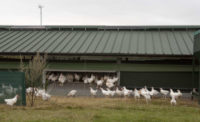Critical Cycles
By Bryan Salvage, Editorial Director
Effective, efficient cooking and smoking processes are key to successful sausage manufacturing.
What does its take for new sausage products to hit the mark with today's demanding consumers? Sausage products must exhibit many attributes including superior taste, texture, and mouthfeel, just to mention a few. When it comes to the sausage-making process, processors know that the cooking and smoking cycles will make or break the end product.
"Cooking and smoke cycles are the most critical steps in sausage manufacturing," says John Grosser, director of marketing, Cher-Make Sausage Co., Manitowoc, WI. "One must have complete control of the process to produce not only a safe product, but to obtain the color, bite [snap], and consistency."
Cher-Make offers a variety of Cher-Make brand summer sausage (original recipe, all-beef recipe, garlic recipe, and Smoky Valley), beef thuringer, natural casing wieners, natural casing deli-style Polish sausage, natural casing Home Game cooked bratwurst, Zesty -Fiesta Bratwurst with Pepper Jack Cheese and Jalapeno pepper, old-style ring bologna, garlic ring bologna, less fat ring bologna, beef ring bologna, old style stadium hot dogs, Snackers original and spicy beef sticks, and soft spread braunschweiger--as well as a range of private-label sausage products.
Customers and consumers are all looking for special attributes in sausage.
"Our customers require a rich, dark-smoke color, which we still achieve with natural hardwood smoke," Grosser says.
Key to sausage success is partnering with technology providers, he adds.
"We do have constant contact with our ALKAR smokehouse technicians," Grosser relays. "Through them, we obtain new and different smoking techniques."
The supply side
Several major cooking and/or smoking technology suppliers name several trends impacting the sausage market.
"[Enhancing] food safety has certainly increased in our customers' thinking process a lot over the past several years, and it continues to increase," says Tim Moskal, director of sales, Lodi, WI-based ALKAR RAPIDPAK Inc. "In another area, I tend to think there is a maturing of the hot dog and sausage [market] a little bit. This is signified by the fact that we see smoked and other types of sausages that have a higher spice and flavoring level. They're beginning to get larger exposure."
Another trend is the move toward more fully-cooked sausage patties and links, which is tied to the growing convenience factor.
"Our customers are looking for equipment that will provide some good color-developing capabilities without adding any agents such as Carmel coloring," says Bill Taylor, regional sales manager, Risco USA Corp., Stoughton, MA. "They are certainly looking at greater capacity per square foot of floor space to minimize cost. Data collection is becoming more important as part of their tracking of batches through the production process, and sanitation of equipment is paramount to the food-safety issues associated with fully-cooked items."
Risco USA represents Double D Engineering, which manufactures the Revoband continuous oven. This oven features a unique airflow system.
"Air speed can be controlled by variable speed fans and set for a different top and bottom speed for each cook zone individually controlled by the PLC," Taylor says. " This allows the processor to achieve excellent color and maintain high yields through the use of steam and dry heat."
The ovens are indirect fired to ensure products of combustion do not come into contact with products being cooked. This also simplifies installation and reduces cost by eliminating the cost of thermal heating while maintaining a very high-energy efficiency.
When asked what his customers are demanding in sausage cooking and smoking systems, Moskal answers: "They want everything [faster throughput, food safety, etc.] today. But the trick is to deliver them at a competitive price."
ALKAR RAPIDPAK has recently put in three new systems for customers, but Moskal is careful not to divulge too much information.
"These are proprietary systems," he explains. "These were systems that were designed to cook and chill product coming off of a coextrusion process. They are highly automated and significantly reduce the amount of labor input — and we can control the position of the product throughout the process."
During the recent International Poultry Exposition that took place in Atlanta, GA, ALKAR RAPIDPAK exhibited its new Cyclone series of linear ovens. Although not geared specifically to the sausage market, it does have a sausage application. The new ovens offer the production capacity of a spiral oven, but in the footprint and process of a linear oven.
Addressing challenges
Sausage processors share several common challenges in making today's products.
"One challenge is to reduce cost," Moskal says. "And the best way to reduce cost is to get reliable, consistent [cooking and smoking] systems. Costs can be manifest in many different ways. It can be labor cost, raw materials cost, and the cost of food safety. It comes down to trying to lower your total cost as much as possible."
Customers are demanding increased throughputs throughout their product spectrum, says Doug Kozenski, sales manager at Heat and Control Inc., Hayward, CA.
"Lines running ten-thousand pounds an hour or more are becoming more common," he says. "Improving finished product yields and obtaining proper product characteristics are also top priorities. Food safety is always important; processors demand assurance that all product reaches the required cook temperature. To achieve these goals, processors have increasingly turned to using high-capacity spiral ovens."
Heat and Control's newest product for sausage processors is the Twin-Drum Spiral Oven, which cooks faster and delivers higher product yields and greater production output than comparable ovens because cooking conditions are independently controlled for each spiral drum and cooking is uniform across all conveyor tiers, the company relays.
True Two-ZoneTM cooking control is achieved by housing each spiral drum in a separate cylindrical enclosure. Air flows uniformly across the conveyor from all sides in a 360- degree pattern to provide consistent temperature across the belt and from top to bottom. This produces faster, more uniform cooking, with no need to overcook to ensure all products are fully cooked. Other ovens enclose both spiral conveyor drums in a single housing. Even if the housing is divided, temperature and moisture seek equilibrium across the barrier to create a single, compromised cooking zone. By using separate enclosures for each drum, Heat and Control delivers true independent cooking control for each spiral conveyor zone.
The Twin Drum Spiral Oven is simpler to clean because the support framework for the spiral conveyor also serves as piping for the clean-in-place system, providing sprays to wash even hard-to reach areas. Cylindrical enclosures eliminate corners where debris can accumulate and raise clear of their bases for 360-degree access to all internal parts.
Kemetec Corp., Charlotte, NC, manufactures smokehouse equipment for smaller processors, such as locker plants, abattoirs, and delis, as well as medium-sized meat packers.
"As to our customers' smokehouse demands it is quite simple: Quality is the key word," says Edwin M. Rimsky, president. "They want a durable unit, capable of performing as trouble-free as possible."
The common challenge of sausage processors of any size has always been cost/quality vs. price/profit, Rimsky continues. '"How much will it cost me to manufacture the quality product I want, and what price can I impose to insure a reasonable profit?'" Rimsky says are the key questions.
Looking ahead
Sausage products will continue evolving, and technology suppliers will continue introducing new systems to meet changing demand.
"Flavor profiles seem to be in the forefront," says Cher-Make's Grosser as he gazes into his crystal ball. "Hardly a week goes by without getting some request wanting us to manufacture a sausage with a change in flavor profile or by adding a different type of cheese. Secondly, stack-pack product will soon all utilize some sort of convenient resealable packaging. Loop-style or bow-tie packaging will probably remain mostly regular or easy-open packaging."
Enhancing food safety will remain a continuous goal.
"We're looking at and are on the forefront of —and this goes back to enhancing food safety — the flash pasteurization [process] we've been working on," says Moskal. "Being able to take sausages or hot dogs and run them through flash pasteurization has the potential to significantly change that business; to change the paradigm as to how these products are handled."
Future challenges will also include how to broaden the line from breakfast items to include snacks, finger foods, and dinner items similar to the growth of brats throughout the country, Taylor says.
"Dough-enrobed and filled products will become more important in the future, and the successful processor will become even more value-added orientated," he adds.
How might sausage cooking and smoking equipment and systems further evolve in the future?
"I will leave this question to the R&D and product-development personnel," Taylor says. "But I feel that the equipment manufacturers will need to partner with the processor to development equipment that will add value and provide solutions to future cooking methods and trends."
"Regarding the future, we feel that creative automation and processing control will continue to be the evolution spearhead ," Rimsky says. NP
Technology providers contributing to this article include:
* ALKAR RAPIDPAK INC., phone (608) 592-3211, e-mail Tim.Moskal@alkar.com, or visit www.rapidpak.com
* Heat and Control Inc., phone (510) 259-0500 or (800) 227-5980, e-mail info@heatandcontrol.com, or visit www.heatandcontrol.com
* KEMETEC Corp., phone (704) 537-2552 or e-mail fnerimsky@aol.com
*Risco USA Corp., phone (508) 230-3336 or (888) 474-7267, e-mail info@riscousa.com, or visit www.riscousa.com





